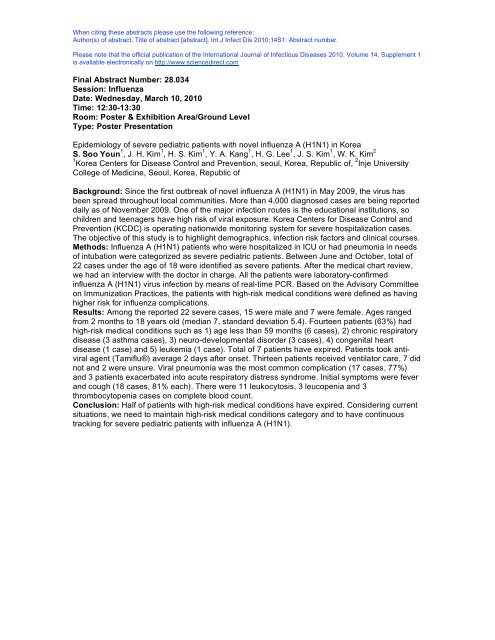14th ICID - Poster Abstracts - International Society for Infectious ...
14th ICID - Poster Abstracts - International Society for Infectious ...
14th ICID - Poster Abstracts - International Society for Infectious ...
You also want an ePaper? Increase the reach of your titles
YUMPU automatically turns print PDFs into web optimized ePapers that Google loves.
When citing these abstracts please use the following reference:<br />
Author(s) of abstract. Title of abstract [abstract]. Int J Infect Dis 2010;14S1: Abstract number.<br />
Please note that the official publication of the <strong>International</strong> Journal of <strong>Infectious</strong> Diseases 2010, Volume 14, Supplement 1<br />
is available electronically on http://www.sciencedirect.com<br />
Final Abstract Number: 28.034<br />
Session: Influenza<br />
Date: Wednesday, March 10, 2010<br />
Time: 12:30-13:30<br />
Room: <strong>Poster</strong> & Exhibition Area/Ground Level<br />
Type: <strong>Poster</strong> Presentation<br />
Epidemiology of severe pediatric patients with novel influenza A (H1N1) in Korea<br />
S. Soo Youn 1 , J. H. Kim 1 , H. S. Kim 1 , Y. A. Kang 1 , H. G. Lee 1 , J. S. Kim 1 , W. K. Kim 2<br />
1 Korea Centers <strong>for</strong> Disease Control and Prevention, seoul, Korea, Republic of, 2 Inje University<br />
College of Medicine, Seoul, Korea, Republic of<br />
Background: Since the first outbreak of novel influenza A (H1N1) in May 2009, the virus has<br />
been spread throughout local communities. More than 4,000 diagnosed cases are being reported<br />
daily as of November 2009. One of the major infection routes is the educational institutions, so<br />
children and teenagers have high risk of viral exposure. Korea Centers <strong>for</strong> Disease Control and<br />
Prevention (KCDC) is operating nationwide monitoring system <strong>for</strong> severe hospitalization cases.<br />
The objective of this study is to highlight demographics, infection risk factors and clinical courses.<br />
Methods: Influenza A (H1N1) patients who were hospitalized in ICU or had pneumonia in needs<br />
of intubation were categorized as severe pediatric patients. Between June and October, total of<br />
22 cases under the age of 18 were identified as severe patients. After the medical chart review,<br />
we had an interview with the doctor in charge. All the patients were laboratory-confirmed<br />
influenza A (H1N1) virus infection by means of real-time PCR. Based on the Advisory Committee<br />
on Immunization Practices, the patients with high-risk medical conditions were defined as having<br />
higher risk <strong>for</strong> influenza complications.<br />
Results: Among the reported 22 severe cases, 15 were male and 7 were female. Ages ranged<br />
from 2 months to 18 years old (median 7, standard deviation 5.4). Fourteen patients (63%) had<br />
high-risk medical conditions such as 1) age less than 59 months (6 cases), 2) chronic respiratory<br />
disease (3 asthma cases), 3) neuro-developmental disorder (3 cases), 4) congenital heart<br />
disease (1 case) and 5) leukemia (1 case). Total of 7 patients have expired. Patients took antiviral<br />
agent (Tamiflu®) average 2 days after onset. Thirteen patients received ventilator care, 7 did<br />
not and 2 were unsure. Viral pneumonia was the most common complication (17 cases, 77%)<br />
and 3 patients exacerbated into acute respiratory distress syndrome. Initial symptoms were fever<br />
and cough (18 cases, 81% each). There were 11 leukocytosis, 3 leucopenia and 3<br />
thrombocytopenia cases on complete blood count.<br />
Conclusion: Half of patients with high-risk medical conditions have expired. Considering current<br />
situations, we need to maintain high-risk medical conditions category and to have continuous<br />
tracking <strong>for</strong> severe pediatric patients with influenza A (H1N1).
















